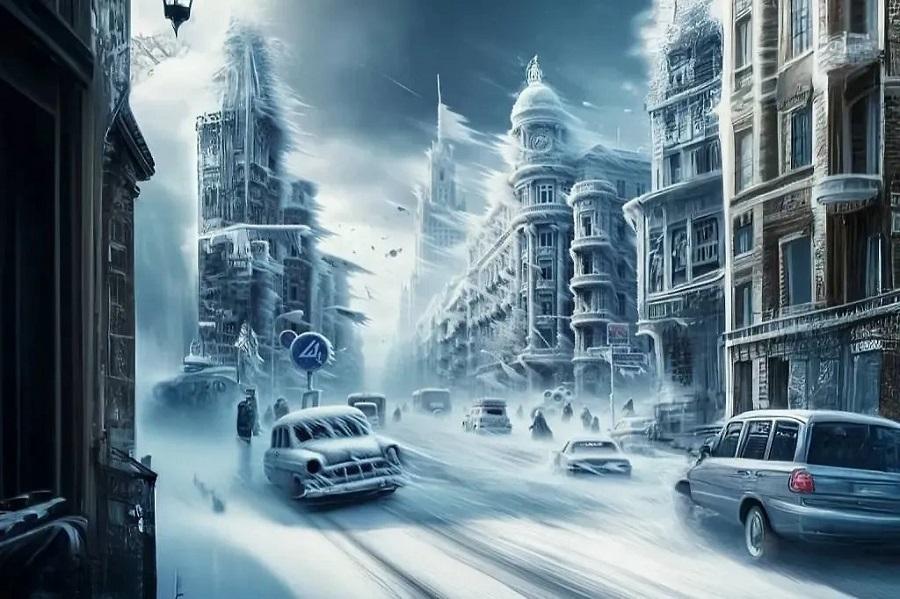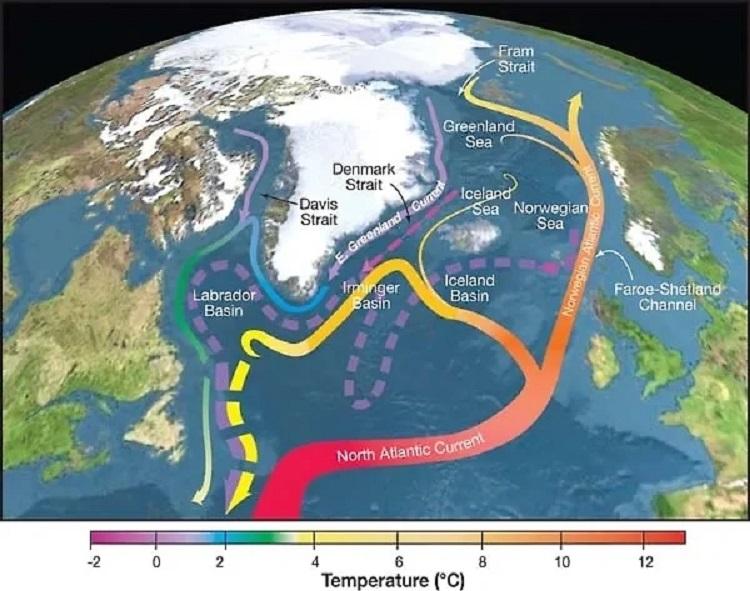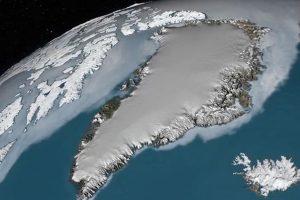
Siberian frosts await Europe. Cover © Shutterstock AI
What is AMOS?
Scientists started talking about the fact that the AMOC ocean current system could stop back in 1960. But only now have computer models appeared that confirm that there is only one step left before the catastrophe in Europe.
In Russia, the Gulf Stream is widely known, which wraps around Europe and brings heat to it from the equator of the Atlantic. However, there is a whole system of currents in the Atlantic Ocean, which are a huge conveyor belt that carries heat, cold and nutrients throughout the ocean.
Some currents act on the surface of the ocean, others in the depths. And the whole system is called AMOC — Atlantic meridional tipping circulation.
AMOC, if written in Latin letters, is part of a huge system of currents called thermohaline circulation. Through it, the Atlantic is connected to the Pacific Ocean by a system of warm currents skirting Antarctica. The movement of water is due to the fact that the Atlantic water is saltier than in the Pacific Ocean.
But back to Europe. Its mild climate is due to the Gulf Stream, which carries heated waters to the north of the Atlantic. At the equator, ocean water evaporates, and the heated water of the Gulf Stream becomes saltier and heavier. Near the European continent, it begins to cool down, becomes even heavier and, sinking to the bottom, unfolds off the coast of Greenland back to the south.
Only individual arms of the Gulf Stream bend around Scandinavia and bring warmth to the Arctic Ocean. The bulk of the water goes back, forming a giant deep current that reaches the shores of Antarctica. Already in early 2024, European scientists published the results of research that shocked them. It turned out that stopping AMOC may not take millennia, as previously thought, or even a hundred years. Drastic changes can happen literally in years.
Scientists: the currents of the Atlantic are waiting for a catastrophe
To obtain such results, a group of Dutch scientists from the University of Utrecht, led by Rene van Westen, PhD, a specialist in climate physics, created a complex AMOC climate model on a supercomputer and included climate changes in recent years, including the active melting of Greenland glaciers. The model included all known data for the last 2000 years.
The results were stunning. It turned out that Europe is already on the brink of disaster. The changes that are about to begin will be irreversible. In the article “The Atlantic Ocean is approaching a critical point” published on The Conversation resource, Rene van Westen argues that data obtained from ocean sensors over the past 10 years indicate that AMOC slowed down to record values in 2023. Glaciers are melting, and the point of no return is almost passed. “As soon as fresh water from glaciers blocks the Gulf Stream, we will witness extreme changes in Europe,” van Westen writes.
The consequences of the disaster for Europe and the world

Atlantic meridional tipping circulation. Photo © Wikipedia
If the oceanic currents of the Atlantic stop or (more likely) change direction, Europe will face disaster. She will bear the brunt of the consequences. Winter temperatures will be the same as in Siberia — up to -30 degrees. In London, the average annual temperature will drop by 10 degrees, and in the Norwegian city of Bergen it will become colder by 15 degrees.
The saying “What is good for a Russian is death for a German” may become relevant. The Dutch are confident that the changes will happen so quickly that countries simply will not have time to prepare for them. A catastrophic slowdown in the AMOC could lead to a rise in sea level of at least a meter. This will be a real disaster for coastal European cities. Iceland, Denmark, Norway, Sweden and Finland will be the first to be hit.
But the world will not stand aside either. In South America, due to the slowdown in AMOC, there may be less rain, and this will lead to drought and heat. In the Amazon, the wet and dry seasons can change places. On the West Coast of the United States, the sea will flood the lowlands, and climate change will lead to the fact that entire sectors of agriculture will be under threat. All this can lead to hunger and lack of drinking water for millions of people.
Russia will not be spared the trouble either. The glaciation of the Arctic Ocean, which will follow a drop in sea temperature, can lead to ice jams in the mouths of huge Siberian rivers flowing north, to water spills and to the reversal of rivers to other regions.
According to some scientists, the events may begin as early as 2025. Climatologists from Utrecht are more cautious in their forecasts. Van Westen believes that events are about to begin, but it is too early to say when exactly this will happen – in 2025 or five years from now. There is too little data: the model does not take into account the increase in carbon dioxide in the Earth’s atmosphere and the effects of climate warming. Nevertheless, the scientist is confident: “We are approaching a critical point.”
Tim Lenton, a climate scientist from Britain, is also sounding the alarm. He believes that the world is on the verge of disaster, and AMOC has slowed down so much that we can talk about a critical point of no return. He believes that the point will be passed in the very near future.
What do Russian climatologists think about the disaster in Europe?
You can laugh at the ambitions of young Dutch scientists. But a number of minds took the study seriously. It is known that in 2024, the leadership of the European Union received a letter signed by 44 serious climate scientists from the United States, Australia, Britain, China, Norway, Israel and nine other countries.
They demanded the immediate adoption of some economic decisions. However, there are no Russian scientists among them. Why? Is it because there is a strong smell of politics here, and the scientists from Utrecht are too young to be seriously listened to?
As it turned out, the reason is different: Russian scientists simply assume that the ocean is a self—regulating system. It is much more complicated than any computer model. For example, Olga Zolina, an oceanologist and climatologist, Doctor of physico-mathematical Sciences, believes that the Gulf Stream can stop under one condition — complete desalination of ocean water.
And the conditions that exist now in the Atlantic have already been there once: they were called Great Salinity Anomaly and observed in the 1960s. And then nothing happened, the ocean adjusted everything by itself. But if such a cataclysm does happen, it will affect the entire planet.
By Maya Novik


